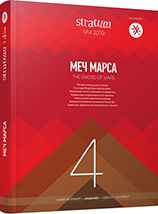Боевые ножи из комплексов позднесарматского времени
Combat Knives from Late Sarmatian Burials
Author(s): Mikhail V. Krivosheev, Anatoly S. SkripkinSubject(s): History, Archaeology, Military history, Ancient World
Published by: Издательский дом Stratum, Университет «Высшая антропологическая школа»
Keywords: Sarmatians; Late Sarmatian time; combat knife; bimetallic knives; set of bladed weapons;
Summary/Abstract: In the burials of the nomads of the Late Sarmatian time, there are often unusual iron knives, which are distinguished by the handle of unusual design. There are two types of these knives. The first type has a solid bronze lining with two rectangular cutouts and a flat area on the top. Handles of the second type are decorated with two separate bronze overlays on each side, the space between which is filled with wooden or bone inserts. A handle of this type also ends with a round head. Most of these bimetallic knives were found in Late Sarmatian burials of the end of the 2nd —3rd centuries AD. The knives of these types are often found in burials with bladed weapons: swords and daggers. There are a few known cases when the scabbard of a knife was fixed on the scabbard of a dagger. It can be assumed that such knives could be used by the Sarmatians in military affairs as an auxiliary weapon.Knives found together with bladed weapons, including those in the same sheath, are known in the monuments of the early Iron Age, in the Scythian period, in several regions of Central Asia, in one of the tombs of the famous Tillya-tepe necropolis in Northern Afghanistan. Researchers suggest that such knives could be used to finish off the enemy or remove the scalp. In the Late Sarmatian time bimetallic knives could have both combat and ritual purpose.
Journal: Stratum plus. Археология и культурная антропология
- Issue Year: 2019
- Issue No: 4
- Page Range: 147-154
- Page Count: 8
- Language: Russian
- Content File-PDF

